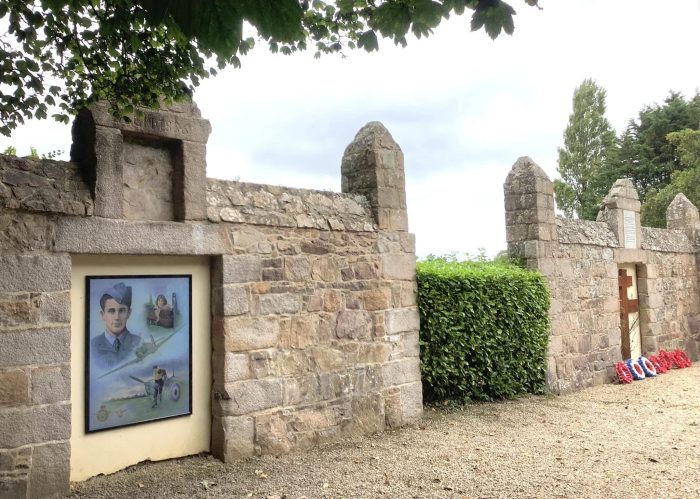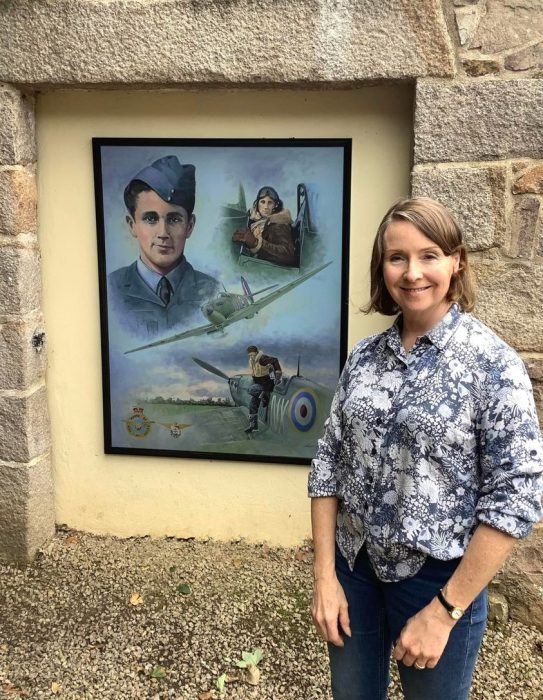
Expanded from a shorter article in the Winter 2023 edition of RURAL magazine
A full-sized and framed reproduction of the memorial painting of Bernard Scheidhauer and his Spitfire is now in place in Rue de Diélament, Trinity, at the old gateway to Diélament Manor.
It fulfils its intended role of drawing attention to the story told on the inscriptions on the monument to a courageous young airman.
The production and mounting of the piece were organised by the Parish of Trinity and especially by its Constable, Philip Le Sueur who arranged for the production and mounting of the piece. Its design was by Jersey artist Catherine (‘Cate’) Hamilton.
Cate said: ‘Feedback to myself and to Constable Le Sueur, has already been very positive and I am very appreciative of his efforts. Those who have stopped at the monument have mentioned that in putting a face to the name in the story, it brings more vividly to life a unique piece of history in this tucked-away corner of Jersey.’
On 10 November, the Lieutenant Governor, Vice Admiral Jerry Kyd, unveiled the image and a plaque he had commissioned at the annual memorial Service for Bernard Scheidhauer during the Season of Remembrance.
Cate Hamilton is currently writing a book to chronicle Bernard Scheidhauer’s life. She outlines his story below:

‘Despite a name of German heritage and his birth in Landau, Germany in 1921 where his father, a French Colonel was stationed with his family, Bernard Scheidhauer grew up a proud young Frenchman in Brest, France.
Watching aircraft as a youngster, he was determined to become a French Airforce Pilot, however the outbreak of World War II and the occupation of France by Germany, thwarted his plans. In October 1940, Bernard’s father encouraged his son and five other friends to make the dangerous crossing of the English Channel to Britain to join the Free French Forces.
The young men left in a 12-metre boat but had miscalculated the fuel for the voyage should the wind prove unfavourable for completing the journey. Inexperienced in navigation and seamanship, they ran out of petrol and found themselves becalmed and adrift off course with inadequate supplies for what turned out to be a period of 10 days lost at sea. ironically, when the wind came up, it was storm force and Bernard with his hungry, weak and dehydrated friends endured terrifying conditions before finally being rescued by the crew of a freighter off the coast of Wales.
In rough shape but undaunted, Bernard had barely recovered when he began service onboard the Naval ship “Courbet” . His desire to fly persisted though and he repeatedly reiterated his request to do so. It resulted in his admission to pilot training school in August 1941 and he graduated in the following June. Now a fully-fledged pilot of the Free French Airforce and flying with the RAF, he was assigned to 242 squadron and took part in the Dieppe operation in August 1942. He then found himself transferred to 131 Squadron, Westhampnett.
After an accident involving another aircraft in flight, Bernard ditched in the sea in early November but with characteristic determination was back at the controls of a Spitfire MkVB and on 18 November at 14.10pm, he flew a “Rhubarb”mission, one using low cloud and poor visibility as cover, to look for possible targets to disrupt German operations, in the region of Caen and Cherbourg.
His Spitfire was hit by anti-aircraft fire and with the fuel line damaged and radio contact with others inoperable, a disorientated Bernard turned to head for the English Channel and his home base. It is said in confusion, with a damaged compass and amid cloudy conditions, he took Jersey to be The Isle of Wight and made an emergency, wheels-up landing in a turnip field close to Diélament Manor in Trinty.
Unhurt, Bernard climbed from his aircraft to be met by local people who had spotted the aeroplane approaching including farmers and a maid from the Manor House. Bernard, on discovering to his dismay that he had landed in German occupied Jersey, attempted to destroy the Spitfire but as there was very little fuel left in its tank, burning it was impossible. Instead, he and some of the small crowd who had gathered, ripped out instruments and removed equipment, some of which was taken by bystanders as souvenirs. Part of the propeller, smashed in the landing, famously takes pride of place in a nearby farmhouse to this day, the prized possession of the family of one of the first people on the scene!
The German forces arrived shortly after and Bernard was detained as a Prisoner of War. He was transported to France within days and thence on to Germany and the infamous Stalag Luft III camp where he was to meet Squadron Leader Roger Bushell, the organiser and leader of what was to become known famously as ‘The Great Escape’. 76 Allied prisoners fled captivity via a tunnel dug under the perimeter fence on 24 and 25 March 1944.
Roger and Bernard travelled by train successfully posing as French workers as far as Saarbruken but were arrested by the authorities when supposedly a sharp-witted German Officer, suspecting that the two were not who they claimed to be, wished them ‘good luck’ in English rather than German and Roger without thinking, thanked him in English, giving the game away. The pair were arrested and held at the local police station. On 29 March, Roger and Bernard were told they were to be transferred to another POW camp but they were never to get very far. A car driven by a plain clothed Gestapo officer accompanied by another was dispatched with the prisoners but a short distance into the journey, Roger and Bernard were told to get out and take a comfort break ahead of the supposed long trip. They were shot in the back at the side of the road. Their bodies were taken to Saarbruken where they were cremated on 1 April 1944. Reportedly, the urns with their ashes were sent to Stalag Luft III as a warning to anyone else who might plan to escape.
All but 3 of those who escaped from Stalag Luft III were recaptured and 50 were executed including Roger and Bernard. They were not all killed at once as depicted in the famous film but in small groups, although all on the orders of the Fuhrer, so incensed was he that any escape had occurred.
Sous Lieutenant Bernard Scheidhauer was only 22 when he died in the pursuit of the liberty we enjoy today. In a world of continued conflict, his courage to strive for freedom and peace remains remain inspirational and must never be forgotten.’





One Response
Thank you so much for this short biography. It’s the beauty of magazines like Rural that you find snippets you would not otherwise think of researching! Fascinating, I await the full story with interest.